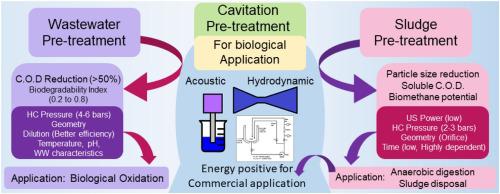Journal of Environmental Chemical Engineering ( IF 7.4 ) Pub Date : 2020-12-08 , DOI: 10.1016/j.jece.2020.104743 Akash P. Bhat , Parag R. Gogate

|
Long treatment times, large quantity of sludge generation, inhibition of micro-organisms and inability to degrade refractory pollutants are common disadvantages of biological treatment processes. Cavitation-based pre-treatment processes can enhance the treatment efficiency of biological treatment including aerobic oxidation and anaerobic digestion. This work presents a critical review on cavitation-based pre-treatment for subsequent biological oxidation process as well as for the treatment and modification of waste sludge for subsequent anaerobic digestion. For wastewater pre-treatment, important metrics to be assessed are COD reduction, and biodegradability index enhancement. In several studies, a BI improvement up to 50–60 % has been observed with cavitation. For sludge pre-treatment, particle size reduction, soluble COD and degree of disintegration (DDCOD) increase, and enhancement of biomethane production potential as the performance metrics have been reviewed. The effect of several process parameters like ultrasound power, hydrodynamic cavitation pressure and geometry, time, and pH are critically reviewed and compared for various studies. Improvements in treatment times, higher enzymatic digestibility, removal of refractory pollutants, and lower inhibition in the biological processes were observed as the key advantages due to the use of cavitation. Optimum cavitation numbers for efficient pre-treatment using hydrodynamic cavitatio lie between 0.05 and 0.15. It is observed that low hydrodynamic pressures are the most advantageous for sludge disintegration and also the process is highly time dependent. Cavitation, especially the hydrodynamic mode, is demonstrated as an economically feasible advanced oxidation-pretreatment for sludge modification and biological oxidation processes leading ultimately to an ‘energy-positive system’. Future studies in this context should mainly focus on the development of continuous flow-pilot scale systems that can be subsequently considered applicable commercially.
中文翻译:

基于空化的废水和废物污泥预处理,以改善生物过程的性能:综述
处理时间长,产生大量污泥,抑制微生物以及无法降解难降解污染物是生物处理过程的普遍缺点。基于气穴的预处理过程可以提高包括好氧氧化和厌氧消化在内的生物处理的处理效率。这项工作对基于空化的预处理进行后续的生物氧化过程以及用于后续厌氧消化的废物污泥的处理和改性提出了重要的评论。对于废水预处理,要评估的重要指标是减少COD和提高生物降解指数。在一些研究中,观察到空化可将BI改善高达50-60%。用于污泥预处理,减小粒径,化学需氧量),并且随着性能指标的审查,生物沼气生产潜力的增加和增强。严格审查并比较了多个工艺参数(如超声功率,流体动力空化压力和几何形状,时间和pH)的影响,并进行了各种研究的比较。由于使用了空化作用,因此,改善了处理时间,提高了酶的消化率,去除了难处理的污染物以及降低了对生物过程的抑制,这是其主要优势。使用流体动力空化进行有效预处理的最佳空化数在0.05到0.15之间。可以看出,低水动力压力对于污泥分解最有利,而且该过程高度依赖时间。空化,尤其是水动力模式,被证明是一种经济可行的高级氧化预处理技术,用于污泥改性和生物氧化工艺,最终导致“能量阳性系统”。在这种情况下,未来的研究应主要集中于开发连续流-中试规模的系统,该系统随后可被认为在商业上适用。











































 京公网安备 11010802027423号
京公网安备 11010802027423号